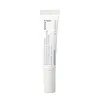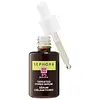What's inside
What's inside
 Key Ingredients
Key Ingredients

 Benefits
Benefits

 Concerns
Concerns

 Ingredients Side-by-side
Ingredients Side-by-side

Water
Skin ConditioningGlycerin
HumectantButylene Glycol
HumectantAlcohol Denat.
AntimicrobialDipropylene Glycol
HumectantAmmonium Acryloyldimethyltaurate/Vp Copolymer
1,2-Hexanediol
Skin ConditioningTorreya Nucifera Seed Oil
EmollientHydroxyethyl Acrylate/Sodium Acryloyldimethyl Taurate Copolymer
Emulsion StabilisingPolyglyceryl-6 Caprylate
EmulsifyingPolyglyceryl-4 Caprate
EmulsifyingPolyacrylate Crosspolymer-6
Emulsion StabilisingSilica
AbrasivePropanediol
SolventSalicylic Acid
MaskingTromethamine
BufferingDipotassium Glycyrrhizate
HumectantSodium Metaphosphate
BufferingGlyceryl Caprylate
EmollientSorbitan Isostearate
EmulsifyingXanthan Gum
EmulsifyingRicinus Communis Seed Oil
MaskingDextrin
AbsorbentTheobroma Cacao Extract
Skin ConditioningLimonene
PerfumingJuniperus Communis Fruit Oil
MaskingPinus Sylvestris Leaf Oil
MaskingJuniperus Virginiana Oil
MaskingLavandula Angustifolia Oil
MaskingCitrus Aurantifolia Oil
CleansingLinalool
PerfumingCitrus Limon Peel Oil
MaskingArtemisia Vulgaris Oil
PerfumingPogostemon Cablin Leaf Oil
MaskingCupressus Sempervirens Leaf/Nut/Stem Oil
EmollientWater, Glycerin, Butylene Glycol, Alcohol Denat., Dipropylene Glycol, Ammonium Acryloyldimethyltaurate/Vp Copolymer, 1,2-Hexanediol, Torreya Nucifera Seed Oil, Hydroxyethyl Acrylate/Sodium Acryloyldimethyl Taurate Copolymer, Polyglyceryl-6 Caprylate, Polyglyceryl-4 Caprate, Polyacrylate Crosspolymer-6, Silica, Propanediol, Salicylic Acid, Tromethamine, Dipotassium Glycyrrhizate, Sodium Metaphosphate, Glyceryl Caprylate, Sorbitan Isostearate, Xanthan Gum, Ricinus Communis Seed Oil, Dextrin, Theobroma Cacao Extract, Limonene, Juniperus Communis Fruit Oil, Pinus Sylvestris Leaf Oil, Juniperus Virginiana Oil, Lavandula Angustifolia Oil, Citrus Aurantifolia Oil, Linalool, Citrus Limon Peel Oil, Artemisia Vulgaris Oil, Pogostemon Cablin Leaf Oil, Cupressus Sempervirens Leaf/Nut/Stem Oil
Water
Skin ConditioningGluconolactone
Skin ConditioningPropanediol
SolventButylene Glycol
HumectantPentylene Glycol
Skin ConditioningAlcohol Denat.
AntimicrobialSilica
AbrasiveSodium Hydroxide
BufferingAmmonium Acryloyldimethyltaurate/Vp Copolymer
Sodium Acrylates Copolymer
Glyceryl Caprylate
EmollientSalicylic Acid
MaskingXanthan Gum
EmulsifyingLecithin
EmollientEnantia Chlorantha Bark Extract
Skin ConditioningSodium Benzoate
MaskingSodium Phytate
Helianthus Annuus Seed Oil
EmollientRosmarinus Officinalis Leaf Extract
AntimicrobialT-Butyl Alcohol
PerfumingOleanolic Acid
Skin ConditioningDenatonium Benzoate
MaskingWater, Gluconolactone, Propanediol, Butylene Glycol, Pentylene Glycol, Alcohol Denat., Silica, Sodium Hydroxide, Ammonium Acryloyldimethyltaurate/Vp Copolymer, Sodium Acrylates Copolymer, Glyceryl Caprylate, Salicylic Acid, Xanthan Gum, Lecithin, Enantia Chlorantha Bark Extract, Sodium Benzoate, Sodium Phytate, Helianthus Annuus Seed Oil, Rosmarinus Officinalis Leaf Extract, T-Butyl Alcohol, Oleanolic Acid, Denatonium Benzoate
 Reviews
Reviews

Ingredients Explained
These ingredients are found in both products.
Ingredients higher up in an ingredient list are typically present in a larger amount.
Alcohol Denat. is an alcohol with a denaturant property. It is created by mixing ethanol with other additives.
This ingredient gets a bad rep because it is irritating and drying - mostly due to its astringent property. Astringents draw out natural oils in tissue, constricting pores and leaving your skin dried out.
However, alcohol denat. is not all that bad.
Due to its low molecular weight, alcohol denat. tends to evaporate quickly. One study on pig skin found half of applied alcohol evaporated in 10 seconds and less than 3% stayed on skin.
This also helps other ingredients become better absorbed upon application.
Studies are conflicted about whether this ingredient causes skin dehydration. One study from 2005 found adding emollients to propanol-based sanitizer decreased skin dryness and irritation. Another study found irritation only occurs if your skin is already damaged.
Small amounts of alcohol are generally tolerated by oily skin or people who live in humid environments.
The rule of thumb is if this alcohol is near the end of an ingredients list, it will probably not affect your skin much.
Also...
This ingredient has antimicrobial and solvent properties.
The antimicrobial property helps preserve products and increase their shelf life. As a solvent, it helps dissolve other ingredients.
Other types of astringent alcohols include:
Learn more about Alcohol Denat.Ammonium Acryloyldimethyltaurate/Vp Copolymer (let's call it AAVC for short) is a synthetically created polymer. It's used as a film-forming agent and used to thicken the consistency of products.
AAVC is able to increase the consistency and viscosity of products due to its large molecule size. It also prevents ingredients from separating.
Butylene Glycol (or BG) is used within cosmetic products for a few different reasons:
Overall, Butylene Glycol is a safe and well-rounded ingredient that works well with other ingredients.
Though this ingredient works well with most skin types, some people with sensitive skin may experience a reaction such as allergic rashes, closed comedones, or itchiness.
Learn more about Butylene GlycolGlyceryl Caprylate comes from glycerin and caprylic acid, a fatty acid from coconut. It has emollient and emulsifier properties.
As an emollient, it helps hydrate your skin. Emollients work by creating a barrier on your skin to trap moisture in, helping to keep your skin soft and smooth.
On the other hand, emulsifiers prevent ingredients (such as oil and water) from separating.
Learn more about Glyceryl CaprylatePropanediol is an all-star ingredient. It softens, hydrates, and smooths the skin.
It’s often used to:
Propanediol is not likely to cause sensitivity and considered safe to use. It is derived from corn or petroleum with a clear color and no scent.
Learn more about PropanediolSalicylic Acid (also known as beta hydroxy acid or BHA) is a well-known ingredient for treating skin that struggles with acne and clogged pores. It exfoliates both the skin's surface and deep within the pores to help clear out buildup, control oil, and reduce inflammation.
Unlike AHAs (alpha hydroxy acids), salicylic acid is oil-soluble. This allows it to penetrate into pores which makes it especially effective for treating blackheads and preventing future breakouts.
Salicylic acid is also known for its soothing properties. It has a similar structure to aspirin and can calm inflamed or irritated skin, making it a good option for acne-prone skin that is also sensitive.
Concentrations of 0.5-2% are recognized by the U.S. FDA as an over-the-counter topical acne product.
It can cause irritation and/or dryness if one's skin already has a compromised moisture barrier, so it's best to focus on repairing that before introducing this ingredient into your routine.
While salicylic acid does not increase sun sensitivity, it’s still important to wear sunscreen daily to protect your skin.
If you are looking for the ingredient called BHA or Butylated Hydroxyanisole, click here.
Learn more about Salicylic AcidSilica, also known as silicon dioxide, is a naturally occurring mineral. It is used as a fine, spherical, and porous powder in cosmetics.
Though it has exfoliant properties, the function of silica varies depending on the product.
The unique structure of silica enhances the spreadability and adds smoothness, making it a great texture enhancer.
It is also used as an active carrier, emulsifier, and mattifier due to its ability to absorb excess oil.
In some products, tiny microneedles called spicules are made from silica or hydrolyzed sponge. When you rub them in, they lightly polish away dead skin layers and enhance the penetration of active ingredients.
Learn more about SilicaWater. It's the most common cosmetic ingredient of all. You'll usually see it at the top of ingredient lists, meaning that it makes up the largest part of the product.
So why is it so popular? Water most often acts as a solvent - this means that it helps dissolve other ingredients into the formulation.
You'll also recognize water as that liquid we all need to stay alive. If you see this, drink a glass of water. Stay hydrated!
Learn more about WaterXanthan gum is used as a stabilizer and thickener within cosmetic products. It helps give products a sticky, thick feeling - preventing them from being too runny.
On the technical side of things, xanthan gum is a polysaccharide - a combination consisting of multiple sugar molecules bonded together.
Xanthan gum is a pretty common and great ingredient. It is a natural, non-toxic, non-irritating ingredient that is also commonly used in food products.
Learn more about Xanthan Gum